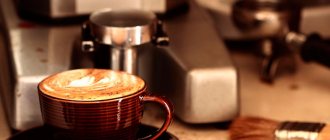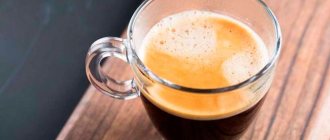The Russian language contains many words that are foreign in origin. The reason for this is that the objects they represent originally appeared in foreign-language societies and came to us with their own name. In our country they often continue to be called the same. However, the graphic form of borrowed words and their correct spelling can cause serious difficulties and discrepancies. For example, cappuccino. After all, many people love this drink for its soft and velvety taste. However, not everyone will be able to write its name correctly. So what is correct: “cappuccino”, “cappuccino” or “cappuccino”?
Correct spelling
If you want to know how to spell a particular word correctly, you should consult a spelling dictionary or a dictionary of foreign words. However, you should not rely solely on the opinion of Wikipedia.
Dictionaries published in the last century do not yet list this word for obvious reasons - after all, the drink itself became widespread in Russia only in its last years. Dictionary of foreign words N.G. Komleva cites the spelling of “cappuccino”. However, the “Russian Spelling Dictionary”, edited by V.V. Lopatina gives something else - “cappuccino”. So why do even dictionaries give different options?
The fact is that the spellings of foreign words, having entered the Russian language, begin life in it in the form of tracing paper, that is, they repeat the original form in Cyrillic. Gradually they assimilate, and the spelling begins to correspond to the norms of the Russian language, one of which is to display the word on paper as close as possible to its phonetic form, that is, to how it is pronounced.
Now, if you pay attention to the release dates of the above dictionaries, you will find that Komlev’s dictionary was released in 2006, and Lopatin’s spelling dictionary – in 2022.
The version given in the later edition should be considered correct. That is, “cappuccino”. And this is logical - after all, today no one, speaking about a drink in Russian, doubles any of the consonants - neither “p” nor “ch”.
Finding the answer
| Question No. 283061 |
How are the names of coffee drinks “frappuccino” and “mochaccino” written? With one “ch”, like cappuccino. With one or two "p"? With one or two "k"s? These words are not recorded in dictionaries. Thanks in advance for your answer.
Russian help desk response
Hello! Please tell me what type of words are espresso, latte, cappuccino. Is it appropriate to focus on the gender of the word coffee? The spelling of cappuccino also raises a question: I have come across different spellings more than once. Thank you.
Russian help desk response
Dictionary fixation (in the Russian Spelling Dictionary of the Russian Academy of Sciences): kapuch ino (without doubled consonants). All three words - espresso, cappuccino and latte - can be used as either masculine or neuter nouns.
Good afternoon How to write correctly: “one kapuch ino” or “one kapuch ino”, considering that kapuch ino is neuter. Specifically for the phrase where there is no word “coffee”, but only “capuch ino”. Thank you.
Russian help desk response
Greetings! Is the spelling of the word “kapuch ino” correct without double consonants? The dictionary of foreign words gives out with double hh. What is correct.
Russian help desk response
The “Russian Spelling Dictionary” of the Russian Academy of Sciences defines the spelling kapuch ino. This word experienced fluctuations in spelling (which often happens with borrowed words in the process of mastering them in a language), so different versions can be found in dictionaries of different years.
Hello. Please tell me what kind of word “kapuch ino” is?
Russian help desk response
Kapuch ino is a neuter noun.
Russian help desk response
Please tell me how to spell the phrases: coffee (“)A(a)rabica(“) and (“)R(r)obusta(“); coffee (“)K(k)ap(p)uch(h)ino(“) and (“)E(e)spresso(“)? Thank you!
Russian help desk response
Good afternoon again. I have a question that I can’t wait for an answer to (needed for editing the text): how to spell the word “cappuccino” correctly. In one of the latest programs “Speaking Russian” by “Echo of Moscow” they talked about writing a double consonant, in my opinion “ch”, and gramata.ru says that you need to write “kapuch ino”. How is that correct? Sincerely, Svetlana
Russian help desk response
The correct spelling in Russian, according to the Russian Spelling Dictionary of the Russian Academy of Sciences: _ kapuch ino_ (without doubling consonants).
Good afternoon, please tell me how to spell the word “cappuccino”. The fact is that gramata.ru gives the option “kapuch ino”, and “Echo of Moscow” talked about a double consonant, but I don’t remember which one. Sincerely, Svetlana
Russian help desk response
The spelling of words can be checked in our electronic spelling dictionary: _ kapuch ino_.
Which is correct: “puzzles” or “puzzles”. An English word contains two z's, should it be transliterated letter to letter? It is often written “cappuccino”, for example, and in the Italian version cappuccino. Sincerely, Dina Korzhevskaya.
Russian help desk response
How to correctly spell the word cappuccino) cappuccino) cauccino) cappuccino. Thank you! M. Ivanova
Russian help desk response
Correct: https://dic.gramota.ru/search.php?word=%EA%E0%EF%F3%F7*&lop=x&gorb=x&efr=x&ag=x&zar=x&ab=x&sin=x&lv=x&pe=x&az=x [kapuch ino].
Which is correct: cappuccino or cappuccino?
Russian help desk response
Russian help desk response
Please use the "Word Check" window.
Is it written “Kapuch chino” or “Kapuch ino”?
Russian help desk response
How to spell the word kapuch ino? There are options for cappuccino, cappuccino, etc. How is that right?
Russian help desk response
Source
What kind: masculine or neuter?
For many years there has been debate about whether the word “coffee” is “he” or “it.” It is perceived by ear as “it,” which is why many people use it that way: “The coffee is too strong,” “The latte is a little hot.” According to the rules of the Russian language, the name of the invigorating drink is written and pronounced as a masculine gender, that is, “he”.
It must be said that the contradictions began with the fact that previously words borrowed from foreign languages that ended with the vowel “e” were used as neuter nouns. However, in fiction, “coffee” was written as “he.” The fact is that in those days when the drink first appeared in Russia, it was called exclusively “coffee” or “coffee”. This went on for quite a long time, and only after many years the word began to be written and pronounced in the format familiar to us.
But not all Russian writers used the masculine gender; many continued to use the neuter gender: delicious coffee.
In 2002, the Ministry of Education of the Russian Federation made significant adjustments to the controversial issue. Now the word “coffee” is allowed to be used in both the masculine and neuter gender. It is worth noting that the last option is only appropriate in colloquial speech. It is strongly recommended to write “coffee” in the masculine gender. If a word is used to name a tree on which beans grow, it is said and written - “it”.
In foreign languages, “cappuccino” has only the neuter gender. In Russian, two variants are allowed:
- delicious cappuccino, sweet latte;
- delicious cappuccino, sweet latte.
In contrast to the strict rules regarding the word "coffee", nouns that refer to milk drinks are also allowed to be pronounced and written in the neuter gender.
What is stronger than a latte or cappuccino, espresso and Americano?
The strongest coffee is espresso . The only thing stronger than espresso is espresso-dopio , which is prepared using twice as much coffee.
Americano is a diluted espresso, so it certainly cannot be called strong.
It is believed that Americano was invented by the Italians. During the war, they prepared coffee for the American military, which they were accustomed to at home. At a time when Americans rejoiced at the taste and aroma of the drink, Italians laughed at them, because they believed that in America people could not know what real coffee tastes like.
Lattes and cappuccinos are made by adding milk to espresso using a special technology. These two drinks taste very different. A cappuccino is stronger than a latte, so it has a stronger bitterness and aroma.
What is stronger than a latte or cappuccino, espresso and Americano?
History of the word
The birthplace of the name, as well as the drink, is Italy, and there the word is written as follows - “cappuccino”. According to one version, it was invented by the monks of the Capuchin Order. Since drinking coffee did not correspond to the ascetic life of the members of the order, they came up with the idea of mixing it with milk.
The second version of the origin of the name is also associated with this order. The color of the finished drink is very similar to the clothes of monks - brown below, white above.
There is a third explanation - the word “cappuccio” translated from Italian means “hood”. After all, this object looks like a cap of frothed milk rising above a cup of coffee. By the way, the name of the monastic order, whose members wore pointed hoods, also came from this word. And the family of capuchin monkeys also owes its name to the hood of hair on the top of the head of each of its representatives.
Examples of use in sentences
The correct spelling of the name of the coffee drink can be found in a spelling dictionary. To understand how best to use words in Russian, here are some simple examples:
- The cafe makes incredibly delicious cappuccino coffee.
- We invite you to try an amazing cappuccino with the addition of citrus syrup.
- The cappuccino turned out sweet.
- A cup of aromatic cappuccino and a muffin is my breakfast.
It is better to avoid the following spellings:
- I really love a hot cappuccino with fresh rolls.
- Today you will find a promotion: “One cappuccino free if you order two espressos.”
Cappuccino is a favorite coffee and milk drink in many countries. Of course, the correct spelling will not make the amazing taste worse. But we all want to be literate and know how to write and pronounce words in Russian. Let us remind you once again: cappuccino is written this way, despite the fact that in foreign languages the name “cappuccino” uses double consonants “p”, “s”.
What the dictionary says
In Russian, the spelling of borrowed words causes a lot of controversy. This coffee drink was sorted out quite a long time ago. Like the vast majority of Italian concepts, it contains many consonants. In the Russian dialect, some consonants are not used in double spelling.
The spelling dictionary says that the correct spelling is cappuccino. Without extra letters and with an “o” at the end. However, one can observe the use of forms of the word cappuccino or cappuccino in public institutions and the media.
Word migration
Within the framework of one culture it is impossible to give names to all objects in the world. Some terms seem more cumbersome compared to foreign analogues, others cannot give a complete picture of the thing, and sometimes there is simply no suitable definition in the language. Ask your grandmother as often as you like: “Cappuccino – he or it?” How to spell the mystery word correctly? She most likely doesn’t know because she’s hearing it for the first time and associates it with some Italian composer.
As they are borrowed, proper names become untied from specific brands and turn into common nouns. They may adapt to the demands of their “new” language or experience severe delays in morphological adaptation. That is, they do not accept the new rules!
international experience
Now you know that everything for a cappuccino is correct: “he” or “it”. Place it in any gender and you won’t go wrong! Or you can focus on the implied word “coffee”. After all, all the exotic items on the barista’s menu are methods of grinding beans for brewing and preparing the same drink according to certain rules. Although there are nuances here too. After all, in the languages from which the concept was borrowed, it was masculine:
- Italian cafe;
- Dutch koffie;
- Arabic gahva and many others.
And Russian grammar identified the word as something inanimate. Moreover, there was a strict association with “drinking” and “drinking”. A situation similar to cappuccino: “it” or “he” - they couldn’t decide right away. Both forms had equal rights since the 17th century, but at some point the intelligentsia rebelled, and calling coffee in the masculine gender began to be considered a sign of an educated person. This demonstrated that the speaker knew the origin of the term and followed all the rules.
Closer to 2010, the situation changed, and dictionaries made the option with “it” acceptable as a colloquial one. That is, you now do not make a mistake, regardless of your choice.
At the household level
What's the result? Cappuccino is “he”! Or “it”, as you wish. Feel free to place any order:
- One cup of cappuccino.
- One cappuccino.
- One cappuccino.
Linguists will not have the slightest complaint against you. However, to this day there are people who are intolerant of new trends. They believe that in most situations it is appropriate to refer to the masculine gender. And this is easy to justify with a chain of interrelated and dependent terms:
- cappuccino – “he” in Italian;
- this is coffee - and therefore also “he”;
- the drink is invariably courageous.
You can get around the awkward plural situation and order just a few at a time. Two or three cappuccinos are identical for "he" and "it". Want more? No problem, they come to the rescue:
- glasses;
- cups;
- portions.
In this case, the question (“Bring what?”) is asked to the vessel, and the gender of the numerals with pronouns correlates with the gender of the container itself. Very convenient if you can’t remember the rules or are shy around others:
- Make one glass of Americano.
- Bring a cup of espresso.
- I’ll have a large portion of latte, and my friend will have a small portion of ice.
A small trick, but it makes life so much easier!
Nuances of preparation and subtleties of use
Cappuccino is created through the skillful hands of a barista and a special technical device - a cappuccino maker. With its help, milk is brought to a fine-bubbly substance. In cafes and restaurants, the drink is created in an expensive coffee machine with a steam pipe.
How do you get cappuccino coffee - a recipe for a “solo performance” of a coffee machine:
- First the espresso is brewed.
- Next, it is poured into a warm cup.
- No more than half of the milk is poured into the pitcher (foamer), since foam increases the volume of the drink by about 100 percent.
- Before starting foaming, condensate is drained through the steam tap of the unit.
- Then the tube is immersed in milk one or two centimeters, and the machine is turned on.
- To create a whirlpool, the tube is placed and rotated at a certain angle.
- After the required amount of foam appears, the tap is closed and the tube is removed from the pitcher.
- Finally, the foam is distributed as evenly as possible over the surface of the drink.
For your information: in the Apennines they like a cool cappuccino, and in Ireland - with cream liqueur.
By the way, you can make cappuccino coffee at home, even if you don’t have a coffee machine with a cappuccino maker in your house. This recipe has been tested not just for years - for centuries!
So:
- Pour two small spoons per 100 milliliters of water into a Turk and put it on fire.
- Mix 50 milliliters of milk and high-fat cream.
- The creamy milky consistency is heated, but not boiled. Compared to Old Testament times, this can now be heated in a microwave oven in half a minute, or at most in a minute.
- Using a mixer, blender or whisk, beat the thick foam until it forms small bubbles.
- Brewed coffee is filtered through cheesecloth.
The most delicate milk foam is poured slowly and in a thin stream
- Coffee is poured into a heated cup, milk is poured on top of it, after which foam is laid out.
- Sprinkle powdered sugar onto cocoa powder and mix them together. The “decoration” is ready!
- Remember, sugar is not added to drinks, but served separately.
- Topping in the form of aromatic syrup and as a sugar substitute is added before pouring milk into the bowl.
According to a centuries-old tradition, cappuccino coffee is prepared and consumed during breakfast, and served in porcelain or ceramic mugs. You can use bulk dishes, but according to the rules, the foam layer should not just go along the level of the top edge of the cup, but slightly higher. Some snobs eat the foam first, skimming it off with a spoon, and then taste the coffee. This is wrong because the incomparable taste of the puff pastry is lost.
It is not customary for Italians to drink cappuccino after a meal, because milk slows down and significantly disrupts the normal course of digestion.
For cappuccinophiles, the priority is cups with a narrowed bottom, medium-sized middle part and widened top. In such savory cups, the designs on the foam surface are more noticeable. Although no one forbids filling the elixir into crystal glasses, as is usually done with lattes.
The drink comes with a teaspoon so you can sip and taste the drink while waiting for the moment when the coffee has cooled to an acceptable temperature and you can drink it without the risk of burning your tongue and palate.
Cappuccino for weight loss
By the way, if this type of coffee helps the consumer’s fight against excess weight, it is with a temporary effect due to dehydration of the body. Logically, if you think about it, then full-fat milk, and even with sugar, on the contrary, predisposes to an increase in the calorie content of the drink, which means there is no talk of losing weight.
To be fair, we must say that there is a special fat-burning cappuccino on sale that suppresses appetite. The secret of effectiveness lies in the miraculous properties of caffeine.
This alkaloid is necessarily present in any drink made from natural coffee, and cappuccino coffee for weight loss is no exception. Especially if the drink was prepared from a combination of Arabica and Robusta, then be prepared to get caffeinated, since Robusta contains more than enough of this alkaloid.
In connection with all this, the question arises: are pregnant women and small children allowed to drink cappuccino? Despite the considerable percentage of milk in the product, it is advisable for this category of consumers to do without cappuccino due to the stimulating properties of caffeine. It is recommended to drink cocoa or a glass of hot chocolate instead.
“Coffee” – he or it?
Today, coffee is one of the most popular drinks among residents of different countries of the world. Over many years, and in some countries even centuries of love for this drink, people have come up with a large number of its varieties, but...
But it turns out that coffee is not only a drink beloved by many, but also a subject of controversy. The question is, “What kind of word is “coffee”?” is very popular and has already become boring to many of his admirers. Writers and philologists have been fighting for the masculine gender for centuries, self-confident grammarians argue with them and defend the form “it,” and those who don’t know rush between these two opinions in an attempt to understand which option is correct. It is precisely because of misunderstandings with the gender of this word that it has become difficult to choose the appropriate definitions for it - “delicious” or “tasty”, “fragrant” or “fragrant”, “what” or “which”, etc.
So what do you call coffee when ordering it, for example, in a cafe or restaurant?
How to drink cappuccino?
You often see a similar question on forums and hear from unenlightened people. So, how to drink cappuccino ? Any coffee, like wine, should be drunk slowly, feeling all the notes of taste and enjoying the aroma. The main rule to follow is to drink cappuccino with foam. There is no need to eat the foam with a spoon separately from coffee or as a bite with it. Drink wisely - drink immediately with foam. If, after taking a sip, a streak of milk appears above your lips, you are drinking cappuccino exactly as you should drink it.
And a couple more facts. In Italy, people drink cappuccino only in the morning, and in the afternoon or for dinner they choose other coffee drinks. In some other countries (France, Germany) they choose the evening for this coffee, and add chocolate chips or cinnamon. In the Balkans or in the USA, cappuccino is drunk at any time of the day, since there are no special traditions there.
In what glasses are latte, cappuccino, espresso and Americano served?
Coffee is served in cups or Irish glasses:
- latte – 60 ml, latte macchiato – 250-300 ml or in an Irish glass 240-360 ml
- cappuccino – in a cup that flares upward 180 ml
- espresso – in a cup with thick walls 60 ml
- double espresso – 100 ml
- espresso-lungo – 90-100ml
- espresso corretto – 250-500ml
- espresso-romano – 60 ml
- espresso macchito – 60 ml
- Americano - 150 ml.
In what glasses are latte, cappuccino, espresso and Americano served?
Glasse or glasse
There is a lot of information on the Internet regarding the correct spelling of this French word. Glace (glace) is translated as “frozen” . As with most words of French origin, the emphasis in it is on the last syllable - glace. There is a version that this wonderful drink, consisting of coffee and ice cream, was invented in Austria.
According to the latest, most complete edition of the spelling dictionary, the correct spelling of this word is considered to be glace, with one letter “s”. The Wikipedia dictionary provides slightly different information. Various forms of writing are allowed there: both glasse and glace.
It is important to remember here that in the original the word glace is written and pronounced as glace, i.e. with one letter “s” . Therefore, it passed into the Russian language unchanged.
All the most interesting iced coffee recipes are collected here.
Video: How to make espresso correctly
To prepare 1 cup of strong aromatic espresso you need 7 g of coffee and 30 ml of water. To prepare espresso doppio, the amount of coffee is doubled, but the amount of water remains the same. Esperso lungo has a mild taste and weak aroma, since only 4 g of coffee per 30 ml of water is used to prepare it.
Espresso
The hallmark of good coffee is the foam on the surface. If there are holes in the foam, it means that the cooking technology has been violated.
Americano is essentially espresso diluted 1:1 with water. The taste of Americano is not as bright and pronounced as espresso, but its lack of bitterness and minimum caffeine have made this drink popular among adherents of a healthy lifestyle.
There are two ways to prepare Americano:
- In Italian. Coffee is brewed in a coffee maker for no more than 25 seconds. After this, add hot, but not boiling water (1:1) to the drink. If you brew coffee longer, the Americano will become overly bitter and strong. The foam is not preserved.
- In Swedish. Bring water to a boil and remove from heat. In 20-25 seconds, brew the espresso and add it to a cup of pre-prepared water. Americano prepared this way has a milder taste. The coffee foam on the finished drink is preserved.
Americano
Cappuccino: history
The coffee drink cappuccino begins its history back in the 16th century, when in a small monastery near Rome, Capuchin monks began adding milk and foam to their coffee. It's not hard to guess where the name came from. In the Middle Ages, cappuccino was considered the drink of the devil, as it gave vigor and was somewhat addictive. To “cleanse” and in order to somehow soften the pressure of dogma, milk and milk foam began to be added to coffee. Another interesting fact from the history of cappuccino: the color of the robes of the Capuchin monks was close to light brown, and the color of the hoods was close to white. Doesn't remind you of anything?
Italian hood
In the middle of the 16th century, this drink appeared in the area where Capuchin monks lived. Since the invigorating drink was black in color and caused pleasure in those who drank it, it was considered the machinations of the devil. And they decided to disguise it under milk foam, covering the black with white. It turned out that the coffee seemed to be covered with a cap. Nowadays this process of adding milk foam when making coffee is called hooding.
And the literal translation of cappuccino is hood. Another story behind the appearance of the name of this drink is its connection with the name of the Capuchin monastic order, who covered the devil’s potion with milk foam.
Wikipedia as to whether cappuccino or cappuccino is correct, answers - it is permissible to write either way. But it is still recommended to be guided by the spelling dictionary of the Russian language, which indicates spelling without the extra letters that Italians love so much.
The spelling of Russian letters and the rules of borrowing oblige us to use the form - cappuccino, without using doubles.
Barista: leaning or not
The Italian word barista came into the Russian language quite recently, and is translated as a bar worker, bartender. In Russia, this word is usually used to describe coffee decorating and coffee making professionals. Some sources (for example, Wiktionary) allow the word barista to be inflected. It is not right. Barista is a new word and has not yet been recorded in spelling dictionaries. Therefore, it is not recommended to incline it . This is a masculine word, indeclinable, with emphasis on the second syllable. You can immerse yourself in the essence of this profession - barista, with the help of this article.
Every new word that appears in the Russian language raises many questions. The biggest changes affected the coffee theme. Italian names for drinks and desserts are becoming increasingly common. It is worth remembering the correct pronunciation and spelling of such words. This will be very useful when visiting any restaurant or coffee shop.
Examples of using the word in speech
Example sentences will help you learn to write and use the name of your favorite drink correctly.
We write as a masculine noun: “this cafe serves the most delicious cappuccino in the city.” And also as a neuter noun: “vanilla cappuccino can improve your mood.”
In the Russian language, like in any other language, some changes are constantly taking place. The history of the spelling of the Italian word is happening before our eyes. It is not known how it will be written correctly in 10-20 years, which gender option will be the main one.
Source
Why is this so
According to historical information, the word cappuccino came to us from Italy. Looking at the transcription, the point of contention becomes obvious. Judging by it, cappuccino would be correct. Or with at least two “p” - cappuccino, or two “h” - cappuccino. Other languages have adopted it with two letters "p" and "ch". Therefore, in English, German and French, it remains unchanged - cappuccino, so they have no problems with how to write cappuccino or cappuccino. Russian philologists decided to simplify and end the debate about how to correctly spell the word cappuccino using such a radical method. There is also a completely illiterate version of this word, but here the spelling catches the eye. Probably, people who write this way are guided by how it is perceived by ear and put the ending “na” after “cappuccia”.
Finding the answer
| Question No. 283061 |
How are the names of coffee drinks “frappuccino” and “mochaccino” written? With one “ch”, like cappuccino. With one or two "p"? With one or two "k"s? These words are not recorded in dictionaries. Thanks in advance for your answer.
Russian help desk response
Hello! Please tell me what type of words are espresso, latte, cappuccino. Is it appropriate to focus on the gender of the word coffee? The spelling of cappuccino also raises a question: I have come across different spellings more than once. Thank you.
Russian help desk response
Dictionary fixation (in the Russian Spelling Dictionary of the Russian Academy of Sciences): kapuch ino (without doubled consonants). All three words - espresso, cappuccino and latte - can be used as either masculine or neuter nouns.
Good afternoon How to write correctly: “one kapuch ino” or “one kapuch ino”, considering that kapuch ino is neuter. Specifically for the phrase where there is no word “coffee”, but only “capuch ino”. Thank you.
Russian help desk response
Greetings! Is the spelling of the word “kapuch ino” correct without double consonants? The dictionary of foreign words gives out with double hh. What is correct.
Russian help desk response
The “Russian Spelling Dictionary” of the Russian Academy of Sciences defines the spelling kapuch ino. This word experienced fluctuations in spelling (which often happens with borrowed words in the process of mastering them in a language), so different versions can be found in dictionaries of different years.
Hello. Please tell me what kind of word “kapuch ino” is?
Russian help desk response
Kapuch ino is a neuter noun.
Russian help desk response
Please tell me how to spell the phrases: coffee (“)A(a)rabica(“) and (“)R(r)obusta(“); coffee (“)K(k)ap(p)uch(h)ino(“) and (“)E(e)spresso(“)? Thank you!
Russian help desk response
Good afternoon again. I have a question that I can’t wait for an answer to (needed for editing the text): how to spell the word “cappuccino” correctly. In one of the latest programs “Speaking Russian” by “Echo of Moscow” they talked about writing a double consonant, in my opinion “ch”, and gramata.ru says that you need to write “kapuch ino”. How is that correct? Sincerely, Svetlana
Russian help desk response
The correct spelling in Russian, according to the Russian Spelling Dictionary of the Russian Academy of Sciences: _ kapuch ino_ (without doubling consonants).
Good afternoon, please tell me how to spell the word “cappuccino”. The fact is that gramata.ru gives the option “kapuch ino”, and “Echo of Moscow” talked about a double consonant, but I don’t remember which one. Sincerely, Svetlana
Russian help desk response
The spelling of words can be checked in our electronic spelling dictionary: _ kapuch ino_.
Which is correct: “puzzles” or “puzzles”. An English word contains two z's, should it be transliterated letter to letter? It is often written “cappuccino”, for example, and in the Italian version cappuccino. Sincerely, Dina Korzhevskaya.
Russian help desk response
How to correctly spell the word cappuccino) cappuccino) cauccino) cappuccino. Thank you! M. Ivanova
Russian help desk response
Correct: https://dic.gramota.ru/search.php?word=%EA%E0%EF%F3%F7*&lop=x&gorb=x&efr=x&ag=x&zar=x&ab=x&sin=x&lv=x&pe=x&az=x [kapuch ino].
Which is correct: cappuccino or cappuccino?
Russian help desk response











